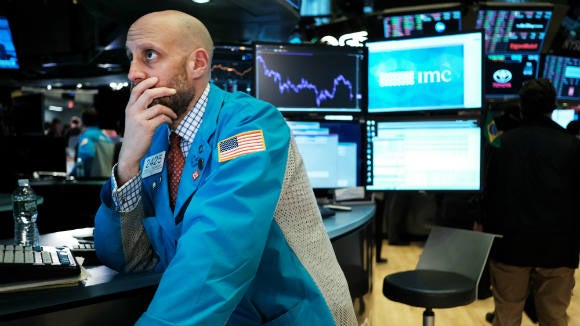U.S. futures slipped as investors weighed the potential damage from sanctions to Russia after President Vladimir Putin recognized two separatist republics in eastern Ukraine and ordered troops sent to them.
Contracts on both the S&P 500 the Nasdaq 100 pointed to a decline on Wall Street when trading resumes after a holiday. The Stoxx 600 Index fell as much as 2% earlier before trimming the loss to 0.1%. A flight to havens eased, as benchmark Treasury yields edged higher to trade at 1.94% and gold slipped.
The European Union proposed an initial package of sanctions targeting Moscow in response to Putin’s decision to recognise the breakaway regions. It follows weeks of warnings from the U.S. and its partners that Russia could be planning to invade Ukraine, something he has repeatedly denied.

The threat of more penalties and disrupted supply kept energy prices elevated, with U.S. benchmark West Texas Intermediate crude trading close to $94 a barrel. German Chancellor Olaf Scholz said he would halt certification of the Nord Stream 2 pipeline. The question now is what the U.S. and its allies would define as an invasion, and what would trigger bigger sanctions.
Sentiment nevertheless turned more positive as traders wager that the unfolding scenario has already been priced into stocks. Russian stocks pared earlier declines and the MOEX Russia traded 4.1% lower. If the situation de-escalates, a quick 5% rally in U.S. stock markets is possible, according to Morgan Stanley strategists.
“Any positive news could reverse the bearish action and lead to sudden jumps in risk asset prices,” Ipek Ozkardeskaya, senior analyst at Swissquote, wrote in a note.
Investors are also continuing to monitor commentary on the U.S. monetary-policy path. Fed Governor Michelle Bowman suggested that a half percentage-point increase in interest rates could be on the table next month if incoming readings on inflation come in too high.
Geopolitical risks have already led investors to pare back bets on how aggressively the Federal Reserve may tighten monetary policy this year to fight inflation.
“The stock market is right to be concerned about current tensions between Russia and Ukraine,” Lori Calvasina, head of U.S. equity strategy at RBC Capital Markets LLC, wrote in a note.
That’s because they “run the risk of exacerbating the challenging inflation backdrop that many investors and companies have expected to improve in the back half of 2022 and present a risk to the margin outlook,” she said.
Some of the main moves in markets:
Stocks
- Futures on the S&P 500 fell 0.3% as of 8:21 a.m. New York time
- Futures on the Nasdaq 100 fell 0.7%
- Futures on the Dow Jones Industrial Average fell 0.3%
- The Stoxx Europe 600 fell 0.1%
- The MSCI World index fell 0.3%
Currencies
- The Bloomberg Dollar Spot Index was little changed
- The euro rose 0.3% to $1.1345
- The British pound fell 0.3% to $1.3555
- The Japanese yen fell 0.3% to 115.09 per dollar
Bonds
- The yield on 10-year Treasuries advanced two basis points to 1.95%
- Germany’s 10-year yield advanced five basis points to 0.26%
- Britain’s 10-year yield advanced six basis points to 1.47%
Commodities
- West Texas Intermediate crude rose 2.9% to $93.71 a barrel
- Gold futures were little changed
Source: here




